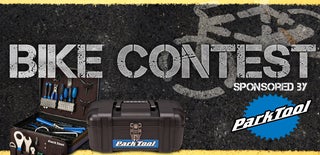Introduction: Toolbox Compatible Bike Valet With Fork Mounts for Pickup Trucks
Do you ever wonder how you could fit your bike into your truck without a hassle? Do you have a toolbox and/or a shortbed pickup truck and have no way to transport your bike other than those pesky bungee cords? Look no further, because with my new design, I will revolutionize the way you transport your bikes. This allows you to not only transport your bike, but you can transport two bikes with a load of equipment side by side, no matter what kind of pickup you have. And best news yet, you could keep your tailgate up!
I don't know about you, but I just bought a $1000 bike to ride the trails and was getting frustrated at the small amount of options I had to transport it. I needed to build my own.
Before I instruct you, I must say this is my first instructable and I also have no responsibility for anybodies bikes damaged. This Project does require a bit of basic pvc cementing, and design skills. You should be able to effectively measure out your trucks dimensions and adapt the design to fit your truck. I will not provide measurements but I will tell you what you need to measure. That being said, here we go.
This project cost me roughly $130. That is quite cheap, and I'm sure you could get the price down quite a bit more based on the fact that I had improvised the design multiple times
Materials needed:
2x- Fork mounts (You could get cheap ones from amazon)
6x- 10' x 1" Sections of Pvc ( I used schedule 40 and recommend you do too)
8x- 1" Elbows
14x- 1" Tee shapes
6x- Elbows with side outlet (3 way elbow)
1x- 1" Cross shape (4 way)
6x- Nuts and Bolts (1.5"-2", #10) (Used to bolt in fork mounts)
2x- Velcro straps
2x- Screws or pins(To be able to remove top part of valet for access to the toolbox)
Tools needed:
Hacksaw
Tape measure
Drill
Pvc primer & Cement
A pair of pliers
Step 1: Designing the Valet
I highly recommend you draw this out and include every measurement before building this. It will save a lot of time, money and frustration. I have no specific measurements being that every trucks bed size varies, but in the pictures, I have tags that will help you a lot if you pay close attention. If I missed something, or you have any questions, feel free to ask in the comment section and I'll get back to you as soon as I can.
Step 2: Building the Beast
Measure every dimension out and dry fit it all together. If you don't know what dry fit is, it means you need to put everything together, without glue. Make sure it all fits and make any necessary modifications. REMEMBER TO MEASURE THRICE, CUT ONCE!!!!! IT'S WORTH THE EXTRA EFFORT!!! Once everything is put together the way it is designed and fits perfectly in your truck with little to no movement, you can begin to prime it in the next step.
Step 3: Priming and Cementing
This part is very important. TAKE A PICTURE AND REMEMBER WHERE EVERY SINGLE LAST PIECE GOES. Prime the pvc. (Priming is not the most important part, but it helps hold everything together. If you're lazy, you don't need to prime it, being what the pvc is being used for, but I recommend it. Once primed and dried, dry fit it together again. This part does require a bit of patience. Take a marker and MARK THE PIECES OF PVC AND THEIR FITTINGS, SO YOU KNOW WHERE TO POSITION THEM ONCE GLUED. YOU ONLY HAVE A FEW SECONDS TO WORK WITH ONCE THE GLUE IS APPLIED, SO YOU NEED TO KNOW WHAT GOES WHERE! YOU DO NOT WANT TO RACK THE RACK! Make sure everything is perfect before cementing it together, I can't stress that enough.
Step 4: Onto the Fun Part... PAINTING :D
The paint can be any color really. I just went with flat black because it matches my bed quite nice. I recommend you go for the good brand other than the cheaper brands. They may save you money in the long run. Short streaky bursts are the best. Make sure it bonds to plastic. Getting one that is weather resistant may help quite good as well.
Step 5: Mounting the Fork Mounts
Please do not screw these in. it is best to bolt them in, or they could easily come out. Drill a pilot hole, insert bolts. put the fork mount on, screw the bolts on and use a drill and pliers to tighten it all up. IT MUST BE TIGHT!
Step 6: Removing the Top Section for Access to the Toolbox
This part is simple. You could drill screws in to be able to remove the top section, but you will need to constantly carry around a screwdriver. I went with this option because it is easier and I only need the toolbox for certain things. If you always use the toolbox, I recommend you drill a pilot hole and use some type of pin that you could easily pull in and out, but one that WILL NOT JUST COME RIGHT OUT. If it comes out, it will be dangerous! Very dangerous.
Step 7: Velcro Straps
Plain and simple step, to keep back wheel from shifting
Step 8: Finished Product
Fits awesome, never moves around. A great DIY project.
Step 9: A Little Extra
I did have to bungee cord the pvc down a bit onto my truck. If you're not careful with cementing the pvc, you may have to as well. I do recommend this whether or not it is perfect. It was my first time working with pvc, so it was a bit crooked.

Participated in the
Bike Contest










